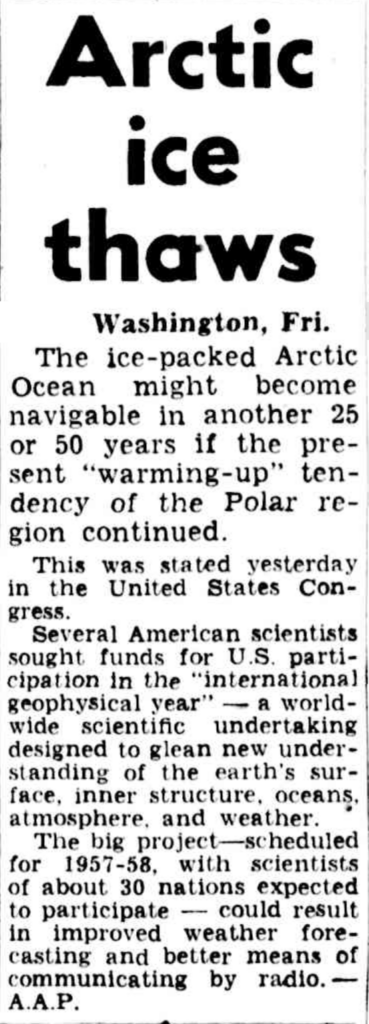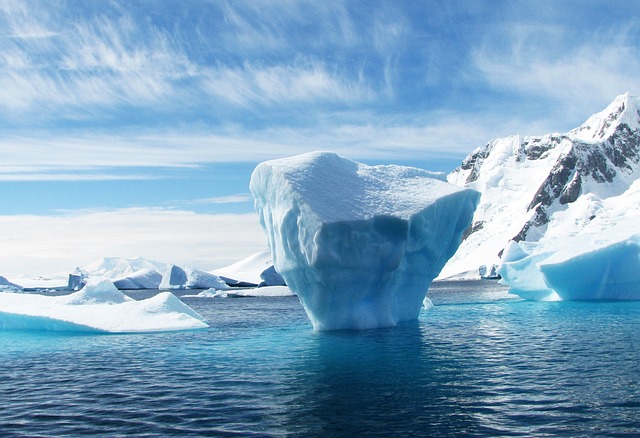- Sea ice shows recent losses, but far less than the total melting of the summer Arctic, as scientists predicted.
- Good data only exists since 1979, and this is not sufficient to make strong claims.
- Historical evidence suggests that the current state of the Arctic may not be as unusual as highly politicised claims argue.
For many years, each northern hemisphere summer has brought fresh concern about the survival of the Arctic ice sheet. Chiefly for its supposed role as habitat for the polar bear, the ‘green’ view holds that the disappearance of summer sea ice would at least symbolically represent a radical transformation – degradation – of the natural environment. Consequently, but counterproductively, the Arctic in particular has been the focus of claims that this change is imminent and a reflection of the powerful scale of anthropogenic global warming, leading to incautious predictions of an Arctic free of summer sea-ice. But the Arctic is not the only region of concern. Glaciers and mountain tops throughout the world, and the Antarctic too, have also served as seemingly powerful representations of global warming, driving countless headlines, commentaries and political statements.
But caution and debate are necessary where much is being driven by symbolism – pictures of decline, which don’t often speak to or encourage an objective and historical understanding. The frozen parts of our planet are extremely hostile and remote, and our access to them is a relatively recent development of our abilities. The first successful expeditions to the North and South Poles were only achieved at the start of the last century. The North Pole’s nearest human settlement, with a population over 1,000, is Longyearbyen, Svalbard in Norway, at 78° north is 650 miles away. The entire continent of Antarctica was unpopulated until explorers and then researchers arrived. Many glaciers too have been beyond human reach until recently. And the satellite era only began to provide a record of the state of the frozen parts of the planet at the end of the 1970s. The study of the cryosphere is a very young science.
However, the concerns about the effect of global temperature rise on poles and other parts of the planet should be taken seriously. Large amounts of water are locked up in glaciers at both ends of the planet, and therefore have the potential to significantly increase sea levels.Predictions about the loss of Arctic sea ice began to grip the news media in the late 2000s. In 2007, the BBC reported predictions by Professor Wieslaw Maslowski of ‘Arctic summers ice-free by 2013’. The same year, National Geographic News quoted NASA climate scientist Jay Zwally stating, ‘the Arctic Ocean could be nearly ice-free at the end of summer by 2012’. The following year, The Independent quoted researcher Mark Serreze of the US NSIDC, that ‘I’d say it’s even-odds whether the North Pole melts out’ that year. This form of claim continued every year since, allowing climate sceptics to catalogue failed predictions. More sober assessments have been produced in recent years, putting off the demise of Arctic summer sea ice until the 2050s. However, this leaves unanswered the questions that arise out of such dramatic failed predictions, and institutional science’s failure to address both its population’s categorically alarmist output and to reign in political comment that emphasised it. In this respect, climate sceptics who have demonstrated the alarmist tendency have a very good point, which should not be ignored either.

As the above chart of Arctic sea ice from the Nansen Environmental and Remote Sensing Center’s Arctic Regional Ocean Observing System demonstrates, a significant trend of Arctic summer sea ice minimum extent certainly exists, and is pronounced in the decade to 2012, where it reaches its minimum. However, since then the trend seems to level off, and this minimum has not been exceeded in a decade, and so that trend – of reduction – seems to have ended. Though scientists were perhaps right to say that a trend was emerging, claims that this would lead to an imminent loss of summer sea ice were premature. Manifestly, and despite a clear signal developing, the scientific understanding of the Arctic and its mechanisms that produce changes in sea ice extent were not sufficiently understood to make safe predictions.
The point here is to emphasise that debate exists about the sensitivity of Arctic sea ice to global temperature. Whereas the Arctic region in particular is highlighted in many attempts to demonstrate the urgency of climate change, scientific consensus to support such claims does not exist, because the science is so young. This debate should be encouraged, and evidence allowed to be presented to support various perspectives. But instead, Arctic researchers have been hasty in supporting political arguments. Sceptics, who may well be outside the consensus on other matters, are surely right to point to the shortcomings of a novel science and its claims.
It is only by such a debate happening that premature, and likely inaccurate claims can be corrected, and the totality of evidence considered. For example, sceptics argue that the evidence from the Satellite era, by starting at 1970, creates a false impression of radical decline, whereas the Arctic’s ice cover extent has always been volatile, and extremely variable at climate timescales. Good evidence supports this view.
An article in the November 1922 edition of the American Meteorological Society’s Monthly Weather Review reported that,
The Arctic seems to be warming up. Reports from fishermen, seal hunters, and explorers who sail the seas about Spitsbergen and the eastern Arctic, all point to a radical change in climatic conditions, and hitherto un- heard-of high temperatures in that part of the earth’s surface.
And that,
In fact, so little ice has never before been noted. The expedition all but established a record, sailing as far north its Sl0 29′ in ice-free water. This is the farthest north ever reached with modern oceanographic apparatus.
This is picked up by newspaper accounts of the time. In 1923, an edition of the Newcastle Morning Herald & Miners Advocate reported that ‘something has happened in the Arctic regions equivalent to a kind of glacial overthrow […] The giant ice cap has retreated as though in a flash.’
In five years or so the ice cap as regards what we may call its rim has retreated from the lowest point of Greenland, from nearly all Iceland, from Spitsbergen, from certain other points, and from the seas as connecting them.
As regards Spitsbergen, where until five years ago, the summer temperature of the waters about it was never much above more than 5 degrees above freezing point, in 1921 it rose to as high as 28 [above].
Photographs have been taken of scenes in various places freed of ice for the first time in recorded history. They include certain parts of lower Greenland and a number of islands. A review says:- “Where formerly there were great masses of ice there are now only accumulations of earth and stones, such as geologists call ‘moraines.'”
This trend appears to have continued into the 1950s. A 1954 article in the Melbourne Argus reported evidence given to Congress that the Arctic may become navigable by the end of the century.

But by then the Arctic had already entered a new phase. And this is most vividly demonstrated by a 2008 paper in the Journal of Geophysical Research, focused on the Russian Arctic in particular, but drawing conclusions about the entire region. The study attempted to reconstruct a series of sea ice extent from a number of historical sources such as ship observations and aerial reconnaissance, and early (1966 onward) visual satellite images.

The satellite era record, which dominates contemporary discussion, is shown in red. The most dramatic recovery from the pre-1950s warming is shown in the Autumn quadrant. And it is in this season that the sea ice minimum extent is typically recorded, and significant increases are shown. The significance of which is that pre-1979 increases in sea ice are omitted from the discussion, and thus the narrow focus of the satellite era may be misleading.
However, there may be good reasons for focus on sea ice data beginning at the end of the 1970s. Some arguments do claim that this is a deliberate attempt to misinform the debate by omitting earlier, inconvenient data. However, starting the data here may be more charitably interpreted as a tacit consensus that pre-satellite era data is simply too difficult to process into reliable information, to compare with satellite era data. There is nothing wrong with this emphasis on recent data, unless it is forgotten – or omitted – that only a very short record exists. Unfortunately, typically this has been the case with the more alarmist interpretations, produced by researchers and political campaigners, in the late 2000s and early 2010s. More unfortunately still, institutional science failed to correct the propagation of these more alarmist interpretations in the media and in politics, and to put them in the light of earlier observational records.
The historical evidence of this kind is not presented here to show that more recent data, from the satellite record, is wrong, or that this recent data is not driven in any part by anthropogenic global warming. What it may suggest, however, is that whereas many views suppose a static or relatively unchanging Arctic, the dynamism of the region may have been underestimated. Historical evidence shows that the region is prone to rapid and significant change and this needs to be debated and understood.
